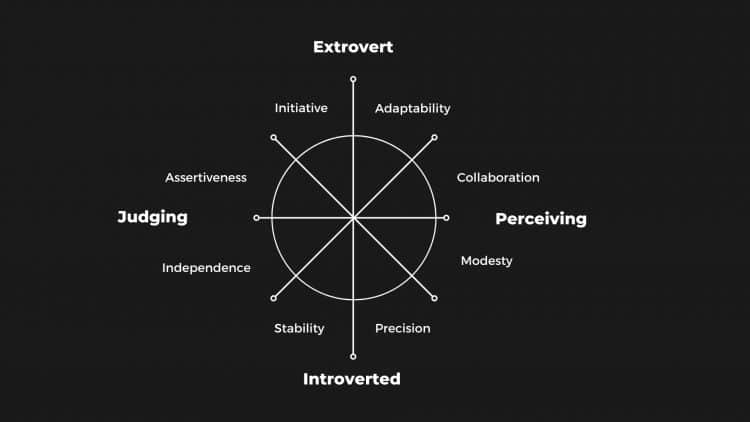I’ve found that personality is a spectrum and while there are many who are either extroverted or introverted, many can also find themselves living somewhere in between the two preferences. But how is that possible? Let’s dig into that in today’s article.
Learn how introverted extroverts vs extroverted introverts think and how the two are different from each others.
Get deeper than just introversion and extroversion and learn how people can also have a preference towards Judging (Professional traits) and Perceiving (Recreational traits)
And learn what extroverted vs introverted traits are and how you can understand these traits. Oh, I also made a video about this.
Extrovert vs Introvert
First, let’s explore the extrovert vs the introvert traits. What is extroversion, and what is introversion?
Extroverted Traits Explored
Extroversion is characterized by a vibrant energy directed outward towards social interactions and activities. Extroverted traits include:
- Assertiveness: A confident engagement with the world, leading initiatives, and voicing opinions boldly.
- Initiative: The propensity to take charge, start projects, and lead groups with enthusiasm.
- Collaboration: A natural inclination towards teamwork, enjoying the synergy of working with others.
- Adaptability: Flexibility in thoughts and actions, readily adjusting to new situations and ideas.
These traits enable extroverts to thrive in dynamic environments, fostering connections and embracing change with ease.
Delving into Introverted Traits
Contrastingly, introversion is marked by a reflective, inward focus. Key introverted traits include:
- Modesty: A preference for understatement and a tendency to downplay one’s achievements.
- Precision: Attention to detail and a methodical approach to tasks, valuing accuracy over speed.
- Independence: A strong sense of self-sufficiency, often preferring solitary work and thought.
- Stability: Seeking consistency and calm in both environments and relationships, valuing routine.
Introverts find strength in solitude and deep contemplation, cherishing quiet moments that recharge their inner reserves.

What if you relate both to introversion and extroversion?
Not everyone exhibits a clear-cut preference for extroverted or introverted traits. Many individuals display a mix of tendencies, challenging the notion of strict personality categories. This is where the MBTI framework provides additional insights, particularly through its Judging and Perceiving dimensions.
Why Judging and Perceiving types are often ambiverts
The MBTI offers a lens to understand how people perceive the world and make decisions. Those with a strong score towards Judging, Professional mindset or Perceiving, Recreational mindset can appear as ambiverts, displaying traits from both introversion and extroversion. This ambiversion suggests a fluid personality type that can adapt to various situations with a unique blend of characteristics.
Introverted Extroverts
An Introverted Extrovert, unlike the Extroverted Introvert, is somebody that can be very social and can enjoy being around other people, but is often shy to put themselves forward in social situations. If somebody comes up and strikes up a chat with you, you’ll be happy and have a great time, but you’re modest and careful not to make too much noise around yourself.
An ambivert, like the introverted extrovert, can come off as quite balanced in terms of introversion and extroversion. Compared to the pure introvert, they will strike you as social and friendly. Compared to an extrovert, they’ll seem shy and quiet. Their social energy is balanced – they have a mild, balanced enthusiasm and energy.
Individuals identified as Introverted Extroverts, with a strong Perceiving preference, embody a fascinating mix of flexibility and introspection. Their Perceiving nature makes them highly adaptable and open to new experiences, leading to a sense of curiosity and a desire for collaboration. Yet, they also possess deeply introverted qualities such as Modesty and Precision, which influence their approach to life and social interactions.
“I may not be the first to speak up, but when I’m comfortable, I love the flow of ideas and energy in a group. It’s about finding that balance between listening and contributing.” – An Introverted Extrovert’s reflection.
This quote describes the Perceiving types mindset, showing their initial reservation and subsequent openness in social settings. Their adaptability allows them to navigate various social situations with ease, yet they retain a core of introspection that guides their interactions. They value meaningful engagement over superficial connections, often leading to a rich inner life that balances their social spontaneity.
Extroverted Introverts
The Extroverted Introvert is somebody that can be very assertive and confident in social settings, but who prefers being in their own company. Often, these types have big goals and ambitions that drive them to go out into the world and engage with others, but these types still need alone time to rest.
An omnivert is somebody that is said to occupy the extreme poles of introversion and extroversion. They can be super social, but also very quiet and reclusive at other times. Extroverted introverts, like Omniverts, can change a lot in how extroverted they are. They vary depending on if they’re in the planning stage of conceiving a path or a vision forward, which they prefer to do alone. Or whether they’re in the execution phase, of implementing a plan, which they prefer to do with other people.
On the flip side, Extroverted Introverts with a Judging preference are characterized by their goal-oriented and assertive nature. They exhibit a strong drive and leadership capabilities, often taking the initiative in both personal and professional spheres. Despite these extroverted tendencies, they deeply value Stability and Independence, traits typically associated with introversion.
“I have a very outgoing lifestyle – I hold events, I do public speaking, and I’m very proactive. I work hard and often push myself to the point of exhaustion. But when I need rest, I crash and I literally do not want to be around anyone. I also spend a lot of time on my own thinking about my plans and goals and where I’m going in the future.“ – An Extroverted Introvert.
This thought reflects the Judging subtypes approach to life and leadership. They are capable of assertive action and decision-making but equally prioritize time for solitude and contemplation. Their preference for structured environments and detailed planning underscores their introverted side, allowing them to thrive in both leadership roles and solitary pursuits.
The Distinction between Introverted Extroverts and Extroverted Introverts
The distinction between Introverted Extroverts and Extroverted Introverts lies not only in their behavior but also in their underlying thought processes. Introverted Extroverts, with their Perceiving preference, view the world with a sense of openness and flexibility, always ready to adapt to new information and experiences. Their thought process is characterized by a willingness to explore and a preference for keeping options open. They’re most driven by play and a need for stimulation and recreation. People are a source of fun and relaxation for them, but they avoid social situations that feel forced or like work.
Conversely, Extroverted Introverts, guided by their Judging preference, approach the world with a plan. They value organization, clarity, and decisiveness, aiming to bring structure to both their internal and external worlds. Their thought process is more linear and goal-oriented, focusing on achieving objectives with a clear sense of direction. They tend to have professional goals and a hardworking mentality, but they regard socializing like hard work – not fun or entertainment.
Are you an introverted extrovert or an extroverted introvert?
To get to know yourself better, take my personality test!

